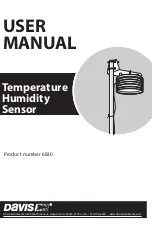
Clean the hardware with a soft, nonmetallic brush. Make sure that the hardware is completely
dry and free from contaminants before returning it to service.
Do not substitute parts or modify the hardware except as described in this document. Use the
hardware only with the chassis, modules, accessories, and cables specified in the installation
instructions or specifications. You must have all covers and filler panels installed during
operation of the hardware.
Do not operate the hardware in an explosive atmosphere or where there may be flammable gases
or fumes unless the hardware is UL (U.S.) or Ex (EU) Certified and marked for hazardous
locations. The hardware must be in a suitably rated IP 54 minimum enclosure for hazardous
locations. Refer to the hardware’s user documentation for more information.
You must insulate signal connections for the maximum voltage for which the hardware is rated.
Do not exceed the maximum ratings for the hardware. Do not install wiring while the hardware
is live with electrical signals. Do not remove or add connector blocks when power is connected
to the system. Avoid contact between your body and the connector block signal when hot
swapping hardware. Remove power from signal lines before connecting them to or
disconnecting them from the hardware.
Operate the hardware only at or below Pollution Degree 2. Pollution is foreign matter in a solid,
liquid, or gaseous state that can reduce dielectric strength or surface resistivity. The following is
a description of pollution degrees:
•
Pollution Degree 1 means no pollution or only dry, nonconductive pollution occurs. The
pollution has no influence. Typical level for sealed components or coated PCBs.
•
Pollution Degree 2 means that only nonconductive pollution occurs in most cases.
Occasionally, however, a temporary conductivity caused by condensation must be
expected. Typical level for most products.
•
Pollution Degree 3 means that conductive pollution occurs, or dry, nonconductive pollution
occurs that becomes conductive due to condensation.
Operate the hardware at or below the measurement category
1
marked on the hardware label.
Measurement circuits are subjected to working voltages
2
and transient stresses (overvoltage)
from the circuit to which they are connected during measurement or test. Measurement
categories establish standard impulse withstand voltage levels that commonly occur in electrical
distribution systems. The following is a description of measurement categories:
•
Measurement Category I is for measurements performed on circuits not directly connected
to the electrical distribution system referred to as MAINS
3
voltage. This category is for
1
Measurement categories, also referred to as overvoltage or installation categories, are defined in electrical
safety standard IEC 61010-1 and IEC 60664-1.
2
Working voltage is the highest rms value of an AC or DC voltage that can occur across any particular
insulation.
3
MAINS is defined as a hazardous live electrical supply system that powers hardware. Suitably rated
measuring circuits may be connected to the MAINS for measuring purposes.











































